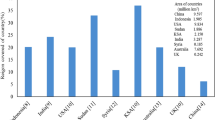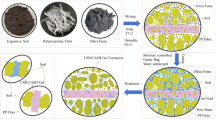Abstract
This study presents the experimental results of the effective utilization of polypropylene (PP) fibre and silica fume (SF) to stabilize the expansive soil subgrade as a possible alternative from the environment, economic, and technical perspective. During the drying cycle, clayey soil undergoes unpredictable shrinkage deformation. The nonrecurring shrinkage behaviour of expansive soil caused the adverse effect on lightweight civil engineering structures. Therefore, expansive soil is not considered suitable subgrade material for paved structure construction. Paved structures constructed on clayey soil subgrade experience severe damages occur in its life cycle. The numerous mechanical, biological, and chemical techniques have been successfully demonstrated to reduce the swelling–shrinkage nature and improve the strength behaviour of expansive soil subgrade. This study aims to utilize industrial waste SF as chemical and PP fibre as a mechanical stabilizer. The mecho-chemical stabilization of expansive soil has been carried out by reinforcing the expansive soil with PP fibre and chemically stabilizing with SF. To evaluate the performance of waste material as a stabilizer, compaction, Atterberg’s limits, free swelling index (FSI), electrical conductivity (EC), pH, swelling pressure, and California bearing ratio (CBR) tests have been conducted on treated and untreated specimens. Over the past few years, images from digital cameras have been successfully used to study crack morphology and various parameters of soils. The image processing technique has been used to evaluate the shrinkage limit by developing the MATLAB program code. The microstructural analysis has been carried out using scanning electron microscopy (SEM) analysis. The varying percentage of silica fume (2%, 4%, and 8%) and polypropylene fibre (0.25%, 0.5%, and 1%) by weight of dry soil were used to stabilize the expansive soil. The results show that the value of CBR increases and the shrinkage area decreases with an addition of SF and PP fibre. The experimental results also show a reduction in Atterberg’s limit with the addition of SF and PP fibre; as a result, the shrinkage behaviour of clayey soil reduces exponentially. The digital image processing technique showed a higher potential to understand the soil morphology for the large area.











Similar content being viewed by others
References
Fouzia M (2017) Composite materials based on recycled polyethylene terephthalate and polyethylene naphthalate for electrical applications. Department of mechanical engineering, ÉTS MONTRÉAL. https://espace.etsmtl.ca/1955/1/MEBARKI%20_Fouzia_th%C3%A8se.pdf
Ranadive MS, Tapase AB (2016) Parameter sensitive analysis of flexible pavement. Int J Pavement Res Technol 9:466–472. https://doi.org/10.1016/j.ijprt.2016.12.001
Srinivas K, Prasad DSV, Rao EVKL (2016) A study on improvement of expansive soil by using CNS (cohesive non swelling ) layer. Int J Innov Res Technol 3:54–60
Rimal S, Poudel RK, Gautam D (2019) Experimental study on properties of natural soils treated with cement kiln dust. Case Stud Constr Mater 10:e00223. https://doi.org/10.1016/j.cscm.2019.e00223
Prambauer M, Wendeler C, Weitzenböck J, Burgstaller C (2019) Biodegradable geotextiles—an overview of existing and potential materials. Geotext Geomembr 47(1):48–59
Singh SP, Rout S, Tiwari A (2018) Quantification of desiccation cracks using image analysis technique. Int J Geotech Eng 12:383–388. https://doi.org/10.1080/19386362.2017.1282400
Liu Y, Su Y, Namdar A et al (2019) Utilization of cementitious material from residual rice husk ash and lime in stabilization of expansive soil. Adv Civ Eng 2019:1–17. https://doi.org/10.1155/2019/5205276
Sharma M, Satyam N, Reddy KR (2019) Investigation of various gram-positive bacteria for MICP in Narmada Sand, India. Int J Geotech Eng. https://doi.org/10.1080/19386362.2019.1691322
Tiwari N, Satyam N (2020) An experimental study on the behavior of lime and silica fume treated coir geotextile reinforced expansive soil subgrade. Eng Sci Technol an Int J. https://doi.org/10.1016/j.jestch.2019.12.006
Shukla SK (2016) An introduction to geosynthetic engineering, 1st edn. CRC Press, New York
Mirzababaei M, Yasrobi S, Al-Rawas A (2009) Effect of polymers on swelling potential of expansive soils. Proc Inst Civ Eng Gr Improv 162:111–119. https://doi.org/10.1680/grim.2009.162.3.111
Mazzoni G, Virgili A, Canestrari F (2017) Influence of different fillers and SBS modified bituminous blends on fatigue, self-healing and thixotropic performance of mastics. Road Mater Pavement Des 20(3):656–670
Wilberforce T, Baroutaji A, Soudan B et al (2019) Outlook of carbon capture technology and challenges. Sci Total Environ 657:56–72. https://doi.org/10.1016/j.scitotenv.2018.11.424
Schneider M, Romer M, Tschudin M, Bolio H (2011) Sustainable cement production-present and future. Cem Concr Res 41:642–650
Tiwari N, Satyam N (2019) Experimental study on the influence of polypropylene fiber on the swelling pressure expansion attributes of silica fume stabilized clayey soil. Geosciences 9:377. https://doi.org/10.3390/GEOSCIENCES9090377
Gray DH, Asce AM, Al-Refeai T (2013) Behavior of fabric-versus fiber-reinforced sand. J Geotech Eng 112:804–820
Eldesouky HM, Morsy MM, Mansour MF (2016) Fiber-reinforced sand strength and dilation characteristics. Ain Shams Eng J 7:517–526. https://doi.org/10.1016/j.asej.2015.06.003
Naithani A, Project H, Himalaya S (2015) Engineering geological investigations of Dik Chhu Hydroelectric Project, Sikkim Himalaya , India Engineering geological investigations of Dik Chhu
Muthukumar M, Shukla SK (2019) Influence of fibres on volume change attributes of expansive soil blended with lime. Proc Inst Civ Eng Gr Improv 172:37–43. https://doi.org/10.1680/jgrim.17.00075
Punthutaecha K, Puppala AJ, Vanapalli SK, Inyang H (2014) Volume change behaviors of expansive soils stabilized with recycled ashes and fibers. J Mater Civ Eng 1561:295–306. https://doi.org/10.1061/(ASCE)0899-1561(2006)18
Malekzadeh M, Bilsel H (2012) Swell and compressibility of fiber reinforced expansive soils. Int J Adv Technol Civ Eng 1:42–46
Kalkan E, Akbulut S (2004) The positive effects of silica fume on the permeability, swelling pressure and compressive strength of natural clay liners. Eng Geol 73:145–156. https://doi.org/10.1016/j.enggeo.2004.01.001
Punthutaecha K, Puppala AJ, Vanapalli SK, Inyang H (2006) Volume change behaviors of expansive soils stabilized with recycled ashes and fibers. J Mater Civ Eng 18:295–306. https://doi.org/10.1061/(ASCE)0899-1561(2006)18:2(295)
Fatahi B, Le TM, Fatahi B, Khabbaz H (2013) Shrinkage properties of soft clay treated with cement and geofibers. Geotech Geol Eng 31:1421–1435. https://doi.org/10.1007/s10706-013-9666-y
Lu Y, Liu S, Zhang Y et al (2020) Freeze-thaw performance of a cement-treated expansive soil. Cold Reg Sci Technol. https://doi.org/10.1016/j.coldregions.2019.102926
Lavanya Rekha P, Vinay Anand D, Veena P (2019) An experimental study to determine the compaction characteristics and california bearing ratio of soil mixed with fly ash and discrete fibre. Int J Mech Prod Eng Res Dev 9:1705–1712
Tiwari N, Satyam N (2019) Experimental study on the influence of polypropylene fiber on the swelling pressure expansion attributes of silica fume stabilized clayey soil. Geoscience. https://doi.org/10.3390/geosciences9090377
Elsharief AM, Zumrawi MME, Salam AM (2014) Experimental study of some factors affecting swelling pressure. Univ Khartoum Eng J 4:4–9
Sivapullaiah P, Sitharam T, Subba Rao K (1987) Modified free swell index for clays. Geotech Test J 10:80. https://doi.org/10.1520/GTJ10936J
Julina M, Thyagaraj T (2018) Determination of volumetric shrinkage of an expansive soil using digital camera images. Int J Geotech Eng 1–9. https://doi.org/10.1080/19386362.2018.1460961
Soundara B, Robinson RG (2009) Influence of test method on swelling pressure of compacted clay. Int J Geotech Eng 3:439–444. https://doi.org/10.3328/IJGE.2009.03.03.439-444
Shi B, Wu Z, Inyang H et al (1999) Preparation of soil specimens for SEM analysis using freeze-cut-drying. Bull Eng Geol Environ 58:1–7. https://doi.org/10.1007/s100640050064
Dash SK, Hussain M (2015) Influence of lime on shrinkage behavior of soils. J Mater Civ Eng 27:04015041. https://doi.org/10.1061/(ASCE)MT.1943-5533.0001301
Moghal AAB, Chittoori BCS, Basha BM (2018) Effect of fibre reinforcement on CBR behaviour of lime-blended expansive soils: reliability approach. Road Mater Pavement Des 19:690–709. https://doi.org/10.1080/14680629.2016.1272479
Ten KW, Shu CY (2015) Effect of particle size and curing temperature on expansion reaction in electric arc furnace oxidizing slag aggregate concrete. Constr Build Mater 94:488–493. https://doi.org/10.1016/j.conbuildmat.2015.07.019
Bouziadi F, Boulekbache B, Hamrat M (2016) The effects of fibres on the shrinkage of high-strength concrete under various curing temperatures. Constr Build Mater 114:40–48. https://doi.org/10.1016/j.conbuildmat.2016.03.164
Goodarzi AR, Akbari HR, Salimi M (2016) Enhanced stabilization of highly expansive clays by mixing cement and silica fume. Appl Clay Sci 132–133:675–684. https://doi.org/10.1016/j.clay.2016.08.023
Kalkan E (2011) Impact of wetting-drying cycles on swelling behavior of clayey soils modified by silica fume. Appl Clay Sci 52:345–352. https://doi.org/10.1016/j.clay.2011.03.014
Ouhadi VR, Yong RN, Goodarzi AR, Safari-Zanjani M (2010) Effect of temperature on the re-structuring of the microstructure and geo-environmental behaviour of smectite. Appl Clay Sci 47:2–9. https://doi.org/10.1016/j.clay.2008.08.008
Author information
Authors and Affiliations
Corresponding author
Additional information
Publisher's Note
Springer Nature remains neutral with regard to jurisdictional claims in published maps and institutional affiliations.
Rights and permissions
About this article
Cite this article
Tiwari, N., Satyam, N. & Patva, J. Engineering Characteristics and Performance of Polypropylene Fibre and Silica Fume Treated Expansive Soil Subgrade. Int. J. of Geosynth. and Ground Eng. 6, 18 (2020). https://doi.org/10.1007/s40891-020-00199-x
Received:
Accepted:
Published:
DOI: https://doi.org/10.1007/s40891-020-00199-x




